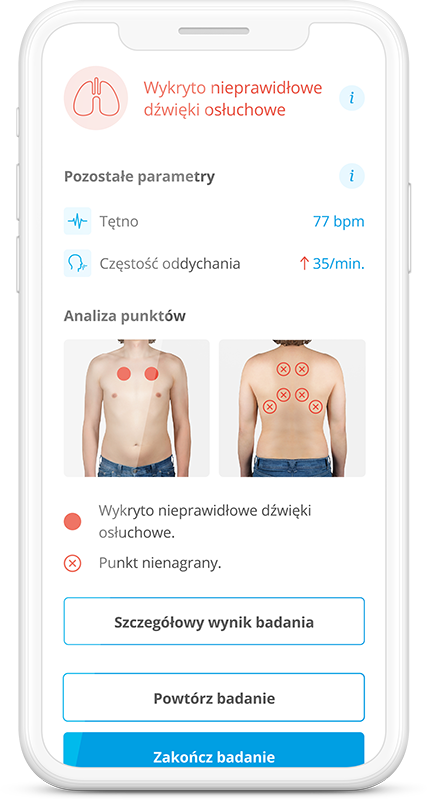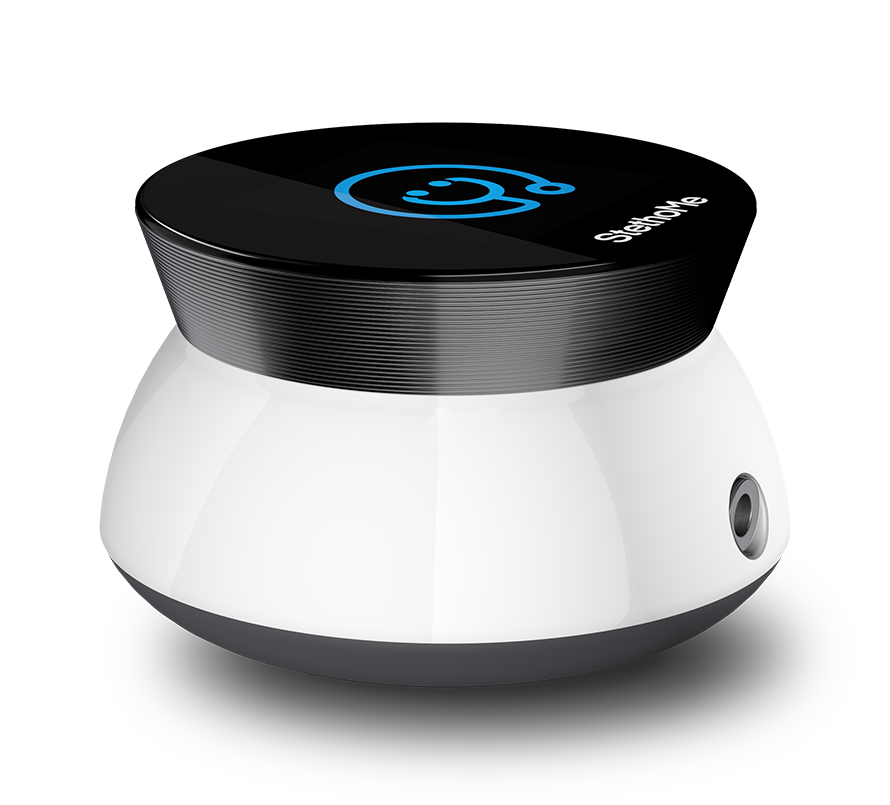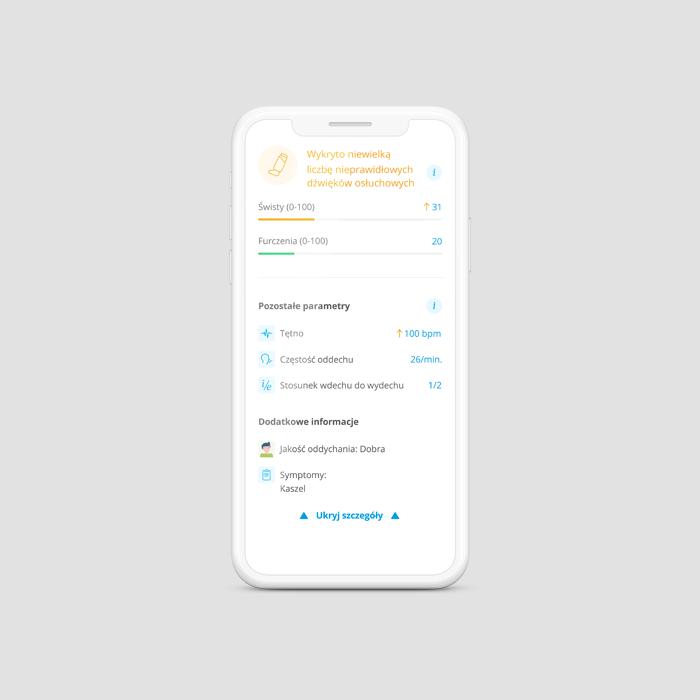Dlaczego StethoMe to idealne rozwiązanie dla rodziców małych dzieci?
Precyzyjna kontrola zdrowia
StethoMe® to rewolucyjne urządzenie, które pozwala rodzicom kontrolować zdrowie swojego dziecka w sposób precyzyjny i łatwy. Umożliwia wykrycia u dziecka nieprawidłowych dźwięków osłuchowych pojawiających się między innymi w przebiegu zapalenia płuc, oskrzeli lub zaostrzeniu astmy. Wynik poznasz od razu.
Wygoda i spokój
Zapomnij o niepokojących Cię wizytach u lekarza w środku nocy. StethoMe® pozwala na monitorowanie zdrowia dziecka w komfortowym domowym środowisku. Dzięki niemu możesz spać spokojnie, wiedząc, że masz kontrolę nad sytuacją.
Wykryj u dziecka dźwięki pojawiające się w przebiegu zapalenia płuc lub oskrzeli

Osłuchaj dziecko w domu, kiedy tylko masz wątpliwości.
Wynik poznasz od razu.
StethoMe® wykryło nieprawidłowe dźwięki? Skonsultuj się pilnie z lekarzem dziecka. Możesz wysłać mu nagranie i wynik osłuchania.
Działaj szybciej.

Wsparcie leczenia
StethoMe® umożliwia współpracę z lekarzem. Możesz udostępnić wyniki pomiarów specjaliście, co pomaga w szybszym diagnozowaniu i leczeniu. To narzędzie, które ułatwia wspólną opiekę nad Twoim dzieckiem.
Informacje w zasięgu ręki
Dzięki StethoMe®, masz dostęp do informacji o zdrowiu swojego dziecka w każdej chwili. Nasza aplikacja przechowuje historię pomiarów, dzięki czemu możesz monitorować długoterminowe zmiany w zdrowiu.
Rodzice często mają wątpliwości, czy podać lek rozkurczający oskrzela, kiedy go podać i czy zadziałał.
Podawaj leki rozkurczające, gdy istnieją medyczne wskazania do ich użycia.
StethoMe® wykrywa świsty i furczenia charakterystyczne dla obturacji.
Nie zgaduj, miej kontrolę.
Zamów StethoMe®
Bezpośrednio od twórców technologii. Kontroluj stan zdrowia swojego dziecka z inteligentnym stetoskopem.
Już od 50 zł za miesiąc.
Skuteczniej zapobiegaj zaostrzeniom

Podawane regularnie leki przeciwzapalne mają zmniejszyć szansę na pojawienie się zaostrzenia.
Zaostrzenie stanu dziecka jest jak wybuch wulkanu. Zapowiadające wybuch delikatne wstrząsy mogą być wykryte przez precyzyjne sejsmografy.
StethoMe® jest niezwykle czułe i wykrywa świsty, do tej pory słyszalne tylko dla lekarza ze stetoskopem. Gdy świsty pojawiają się w trakcie podawania leków przeciwzapalnych mogą być dla lekarza sygnałem do zmiany ich dawkowania.
Osłuchuj dziecko co kilka dni przez 30 sekund. Wykryj w domu ciche świsty i wspólnie z lekarzem zareagujcie właściwie.
Nie czekaj na kaszel, duszności i słyszalne “gołym uchem” świsty oddechowe. Zaawansowane zaostrzenie jest trudniej opanować i może wymagać podania leków rozkurczających.
Działaj wcześniej.
Osłuchaj dziecko w domu i poznaj wynik od razu
Algorytmy sztucznej inteligencji analizują i wykrywają nieprawidłowe dźwięki osłuchowe. System mierzy parametry oddechowe, które pojawiają się w pezebiegu zapalenie płuc i oskrzeli oraz podczas infekcji dróg oddechowych. Są także kluczowe w kontrolowaniu astmy.

1
Włączasz stetoskop oraz aplikację StethoMe® na telefonie. Urządzenia łączą się ze sobą automatycznie.

2
Przykładasz stetoskop do klatki piersiowej dziecka. System podpowie Ci, jak to zrobić, a także poinformuje o błędnym pomiarze lub zbyt głośnym otoczeniu. Zapoznaj się z instrukcją.

3
Widzisz, czy w badaniu pojawiły się dźwięki charakterystyczne dla zapalenia płuc i oskrzeli oraz zaostrzenia astmy.
Jeśli którykolwiek z analizowanych parametrów będzie odbiegać od normy, StethoMe® natychmiast Cię o tym poinformuje.
Pełna historia choroby zawsze pod ręką
Historia choroby
W aplikacji znajdziesz wszystkie badania z informacją o lekach i symptomach. W razie potrzeby pokaż je lekarzowi. Im więcej wie, tym skuteczniej leczy Twoje dziecko.
Wysyłanie wyników
Gdziekolwiek jesteś możesz wysłać dowolnemu lekarzowi SMSem lub e-mailem link do strony z nagraniem i wynikiem badania. Żeby je odczytać, lekarz nie musi znać StethoMe®, ani być zarejestrowany na naszej platformie.
StethoMe® już od 50 zł miesięcznie
Przekonaj się, jak bardzo StethoMe® pomoże Tobie i Twojemu dziecku.

Jesteśmy bezpieczni i wiarygodni
Poznaj StethoMe®. Certyfikowany wyrób medyczny, który jest efektem ponad 7 lat pracy 60 ekspertów i naukowców.
Wyobraź sobie lekarza, który ma wiedzę z wykonania i interpretacji ponad 42 000 osłuchań układu oddechowego u dzieci. Który nigdy nie jest zmęczony, jest w doskonałym nastroju i jest zawsze do Twojej dyspozycji.
Nasza wiedza i doświadczenie
1,5
mln+
oznaczeń osłuchowych
7+
lat badań
42
tys.+
opinii medycznych
60+
światowej klasy ekspertów
Dołącz do grona zadowolonych rodziców
Posiadam stetoskop od miesiąca i naprawdę żałuję, że tak późno trafił w moje ręce. Aplikacja jest mega prosta w obsłudze a zarazem spełnia wiele funkcji tj. analiza badania, a nawet możliwość wysłania nagrania badania do lekarza - to już naprawdę kosmos! Moim zdaniem każdy rodzic astmatyka powinien mieć to urządzenie w swoim domu, daje ono możliwość reagowania w czas, czy to weekend czy to święto, albo wyjazd na urlop kiedy nie ma możliwości dostać się do lekarza. Gdybym mogła to dałabym dodatkową gwiazdkę za obsługę klienta. Panowie są bardzo mili i pomocni, na każde pytanie dostawałam ekspresową odpowiedź. StethoMe jest warte każdych pieniędzy. A spokój rodzica o zdrowie dziecka jest bezcenny. Polecam!
Używam stetoskopu od 3 miesięcy i jest to cud techniki i marzenie dla wszystkich astmatyków. Szybko, bezbłędnie, w domowym zaciszu pozwala wykonać wiarygodne badanie płuc jak i kontrolować w pełni leczenie astmy. Co więcej pełna współpraca lekarska i spokój rodzica dziecka chorego na astmę jest nieoceniona. Jestem zachwycona stetoskopem, ułatwił nam proces leczenia i diagnozy lekarskiej w 100%. Z całą pewnością zyskał miano "cudu techniki dla astmatyków". Dziękuję w imieniu swoim i mojego syna.
Świetne urządzenie. Intuicyjna obsługa i bardzo łatwe w użytkowaniu. Instrukcja postępowania wyświetla się na telefonie. W razie pogorszenia astmy stetoskop pozwala uspokoić obawy albo podjąć działania. Konfiguracja i sparowanie z telefonem zajęło kilka minut. Polecam wszystkim rodzicom dzieci z astmą.
To jest coś, czego szukałam od czasu urodzenia pierwszego dziecka, wtedy miałam tylko termometr. Brak wiarygodnego urządzenia, które mogłoby monitorować stan zdrowia moich dzieci był dla mnie bardzo uciążliwy. Nawet teraz denerwuję się, kiedy wspominam ile czasu spędziłam czekając na wizytę u lekarza, kiedy jedno z moich dzieci kaszlało i nie mogło złapać oddechu, a ja nie wiedziałam co się dzieje. Muszę przyznać, że było to dla mnie straszne przeżycie, straciłam wiele nerwów i własnego zdrowia. Nawet teraz, gdy moje dzieci są już starsze, kupiłabym to urządzenie i używała za każdym razem, gdy są chore. To wspaniałe, że w końcu ktoś je wymyślił!
Partnerzy




Opinie lekarzy o StethoMe®
Osłuchiwanie pozostaje jedną z najważniejszych metod oceny układu oddechowego ze względu na dostępność, bezpieczeństwo i niskie koszty. Badania prowadzone przez StethoMe® w porozumieniu z Uniwersytetem Medycznym w Poznaniu służą obiektywizacji tej metody, w której niezwykle przydatna powinna być analiza akustyczna dźwięków oraz możliwość ich archiwizacji.
StethoMe jest rozwiązaniem, które może pomóc w szybkim i wczesnym badaniu przesiewowym pacjentów z chorobami płuc w domu.
President of the Council of Sciensano, The Belgian Institute for Health
Jest to urządzenie, które może bardzo pomóc także w jednym z problemów, jakie mają na co dzień liczni alergolodzy. Terminy wizyt u alergologa są zwykle wielotygodniowe, czasem wielomiesięczne. Jest mała szansa, aby pacjent w czasie wizyty był w trakcie zaostrzenia astmy (ogólnie obturacji oskrzeli). Musimy polegać na relacji pacjenta, jego rodziców. Szczególnie wątpliwe są relacje rodziców dotyczące obturacji oskrzeli u małych dzieci w trakcie infekcji układu oddechowego. Prowadzi to albo do niedoleczenia lub coraz częściej do nadrozpoznawalności astmy.
Zespół StethoMe®, fachowcy w swojej dziedzinie, stworzyli z wielką skrupulatnością i pasją urządzenie mogące ułatwić życie rodzicom chorujących dzieci. Zabrali się do tego profesjonalnie, dopracowując każdy szczegół i… udało się - pozornie małe urządzenie z dużymi możliwościami.
Publikacje naukowe / Badania kliniczne
W StethoMe® przykładamy olbrzymią wartość do nauki jaka stoi za naszymi rozwiązaniami. Dzielimy się naszą wiedzą publikując wyniki naszych badań w najlepszych naukowych czasopismach i intensywnie współpracujemy ze środowiskiem naukowym.
Frontiers in Physiology
Artificial Intelligence Approach to the Monitoring of Respiratory Sounds in Asthmatic Patients
Background
Effective and reliable monitoring of asthma at home is a relevant factor that may reduce the need to consult a doctor in person.
Aim
We analyzed the possibility to determine intensities of pathological breath phenomena based on artificial intelligence (AI) analysis of sounds recorded during standard stethoscope auscultation.
Methods
The evaluation set comprising 1,043 auscultation examinations (9,319 recordings) was collected from 899 patients. Examinations were assigned to one of four groups: asthma with and without abnormal sounds (AA and AN, respectively), no-asthma with and without abnormal sounds (NA and NN, respectively). Presence of abnormal sounds was evaluated by a panel of 3 physicians that were blinded to the AI predictions. AI was trained on an independent set of 9,847 recordings to determine intensity scores (indexes) of wheezes, rhonchi, fine and coarse crackles and their combinations: continuous phenomena (wheezes + rhonchi) and all phenomena. The pair-comparison of groups of examinations based on Area Under ROC-Curve (AUC) was used to evaluate the performance of each index in discrimination between groups.
Results
Best performance in separation between AA and AN was observed with Continuous Phenomena Index (AUC 0.94) while for NN and NA. All Phenomena Index (AUC 0.91) showed the best performance. AA showed slightly higher prevalence of wheezes compared to NA.
Conclusions
The results showed a high efficiency of the AI to discriminate between the asthma patients with normal and abnormal sounds, thus this approach has a great potential and can be used to monitor asthma symptoms at home.
Hafke-Dys H, Kuźnar-Kamińska B, Grzywalski T, Maciaszek A, Szarzyński K, Kociński J.
PLoS ONE
The accuracy of lung auscultation in the practice of physicians and medical students
Background
Auscultation is one of the first examinations that a patient is subjected to in a GP’s office, especially in relation to diseases of the respiratory system. However it is a highly subjective process and depends on the physician’s ability to interpret the sounds as determined by his/ her psychoacoustical characteristics.
Here, we present a cross-sectional assessment of the skills of physicians of different specializations and medical students in the classification of respiratory sounds in children.
Methods and findings
185 participants representing different medical specializations took part in the experiment. The experiment comprised 24 respiratory system auscultation sounds. The participants were tasked with listening to, and matching the sounds with provided descriptions of specific sound classes. The results revealed difficulties in both the recognition and description of respiratory sounds. The pulmonologist group was found to perform significantly better than other groups in terms of number of correct answers. We also found that performance significantly improved when similar sound classes were grouped together into wider, more general classes.
Conclusions
These results confirm that ambiguous identification and interpretation of sounds in auscultation is a generic issue which should not be neglected as it can potentially lead to inaccurate diagnosis and mistreatment. Our results lend further support to the already widespread acknowledgment of the need to standardize the nomenclature of auscultation sounds (according to European Respiratory Society, International Lung Sounds Association and American Thoracic Society). In particular, our findings point towards important educational challenges in both theory (nomenclature) and practice (training).
Honorata Hafke-Dys, Anna Bręborowicz, Paweł Kleka, Jędrzej Kociński, Adam Biniakowski
European Journal of Pediatrics
Practical implementation of artificial intelligence algorithms in pulmonary auscultation examination
Lung auscultation is an important part of a physical examination. However, its biggest drawback is its subjectivity. The results depend on the experience and ability of the doctor to perceive and distinguish pathologies in sounds heard via a stethoscope. This paper investigates a new method of automatic sound analysis based on neural networks (NNs), which has been implemented in a system that uses an electronic stethoscope for capturing respiratory sounds. It allows the detection of auscultatory sounds in four classes: wheezes, rhonchi, and fine and coarse crackles. In the blind test, a group of 522 auscultatory sounds from 50 pediatric patients were presented, and the results provided by a group of doctors and an artificial intelligence (AI) algorithm developed by the authors were compared. The gathered data show that machine learning (ML)–based analysis is more efficient in detecting all four types of phenomena, which is reflected in high values of recall (also called as sensitivity) and F1-score.
Conclusions: The obtained results suggest that the implementation of automatic sound analysis based on NNs can significantly improve the efficiency of this form of examination, leading to a minimization of the number of errors made in the interpretation of auscultation sounds.
Tomasz Grzywalski, Mateusz Piecuch, Marcin Szajek, Anna Bręborowicz, Honorata Hafke-Dys, Jędrzej Kociński, Anna Pastusiak, Riccardo Belluzzo
ERS International Congress
Respiratory system auscultation using machine learning - a big step towards objectivisation?
A stethoscope, introduced more than two centuries ago, is still a tool providing potentially valuable information gained during one of the most common examinations. However, the biggest drawback of auscultation is its subjectivity. It depends mainly on the experience and ability of the doctor to perceive and distinguish pathological signals. Many research has shown very low efficiency of doctors in this area.
Moreover, most of physicians are aware of this problem and needs supporting device. Therefore we have developed the Artificial Intelligence (AI) algorithms which recognise pathological sounds (wheezes, rhonchi, fine and coarse crackles). Here we present the comparison of the performance of physicians and AI in detection of those sounds.
A database of more than 10 000 recordings described by a consilium of specialists (pulmonologists and acousticians) was used for AI learning. Then another set of more than 500 real auscultatory sounds were used to investigate the efficiency of AI in comparison to a group of doctors. The standard F1-score was used for evaluation, because it considers both the precision and the recall. For each phenomena, the results for the AI is higher than for doctors with an average advantage of 8.4 percentage points, reaching even 13,5 p.p. for fine crackles.
The results suggest that the implementation of AI can significantly improve the efficiency of auscultation in everyday practice making it more objective, leading to a minimization of errors. The solution is now being tested with a group of hospitals and medical providers and proves its efficiency and usability in everyday practice making this examination faster and more reliable.
Tomasz Grzywalski, Marcin Szajek, Honorata Hafke-Dys, Anna Bręborowicz, Jędrzej Kociński, Anna Pastusiak, Riccardo Belluzzo
Artificial Intelligence in Medicine
Fully Interactive Lungs Auscultation with AI Enabled Digital Stethoscope
Performing an auscultation of respiratory system normally requires the presence of an experienced doctor, but the most recent advances in artificial intelligence (AI) open up a possibility for the laymen to perform this procedure by himself in home environment. However, to make it feasible, the system needs to include two main components: an algorithm for fast and accurate detection of breath phenomena in stethoscope recordings and an AI agent that interactively guides the end user through the auscultation process. In this work we present a system that solves both of these problems using state-of-the-art machine learning al gorithms. Our breath phenomena detection model was trained on 5000 stethoscope recordings of both sick (hospitalized) and healthy children. All recordings were labeled by a pulmonologist and acousticians. Trained model shows nearly optimal performance in terms of both sensitivity and specificity when tested on unseen recordings. The agent is able to accurately assess patient’s lung health status by auscultating only 3 out of 12 locations on average. The decision about each next auscultation location or end of examination is made dynamically, after each recording, based on breath phenomena detected so far. This allows the agent to make best prediction even if the auscultation is time-constrained.
Tomasz Grzywalski, Riccardo Belluzzo, Mateusz Piecuch, Marcin Szajek, Anna Bręborowicz, Anna Pastusiak, Honorata Hafke-Dys, Jędrzej Kociński
Conference on Agents and Artificial Intelligence - ICAART
Interactive Lungs Auscultation with Reinforcement Learning Agent
To perform a precise auscultation for the purposes of examination of respiratory system normally requires the presence of an experienced doctor. With most recent advances in machine learning and artificial intelligence, automatic detection of pathological breath phenomena in sounds recorded with stethoscope becomes a reality. But to perform a full auscultation in home environment by layman is another matter, especially if the patient is a child. In this paper we propose a unique application of Reinforcement Learning for training an agent that interactively guides the end user throughout the auscultation procedure. We show that intelligent selection of auscultation points by the agent reduces time of the examination fourfold without significant decrease in diagnosis accuracy compared to exhaustive auscultation.
Tomasz Grzywalski, Riccardo Belluzzo, Szymon Drgas, Agnieszka Cwalińska, Honorata Hafke-Dys
IEEE International Conference on Big Data
Parameterization of Sequence of MFCCs for DNN-based voice disorder detection
In this article a DNN-based system for detection of three common voice disorders (vocal nodules, polyps and cysts; laryngeal neoplasm; unilateral vocal paralysis) is presented. The input to the algorithm is (at least 3-second long) audio recording of sustained vowel sound /a:/. The algorithm was developed as part of the ”2018 FEMH Voice Data Challenge” organized by Far Eastern Memorial Hospital and obtained score value (defined in the challenge specification) of 77.44. This was the second best result before final submission. Final challenge results are not yet known during writing of this document. The document also reports changes that were made for the final submission which improved the score value in cross-validation by 0.6% points.
Tomasz Grzywalski., Adam Maciaszek, Adam Biniakowski, JanOrwat, Szymon Drgas, Mateusz Piecuch, Riccardo Belluzzo, Krzysztof Joachimiak, Dawid Niemiec, Jakub Ptaszyński, Krzysztof Szarzyński
Biochemistry, Molecular Biology & Allergy
Opportunities for domestic monitoring of children with an electronic stethoscope with automatic auscultation sound analysis system
In case of children suffering from chronic diseases of respiratory system, including asthma, it is very important to track any changes in the respiratory system condition. Domestic patient monitoring is becoming more and more popular. It is much more comfortable for patients who are less stressed, being relieved from any necessity to attend doctor’s offices, and are not exposed to pathogens present in medical facilities. Furthermore, it is also important for the attending physician who is provided with documented data. Until now, any aggravation of a past disease has been reported by children’s parents during medical appointments. Such method for providing information entails potential miscommunication, misjudgement and highly biased evaluation. a solution might be an electronic stethoscope, providing easy way to examine children in domestic conditions and to record auscultation results. Currently, it is possible to record auscultation sounds, provide a doctor with remote access to such records, and also to report any appearance of specific sounds and their intensity. Based on collaboration with scientific centres, there is a solution being developed: StethoMe®, a smart stethoscope, designed to provide a patient with a method for domestic auscultation. This system enables recording of auscultation sounds, submitting them to a physician and automatic classification of recorded sounds in four lasses: wheezes, fine crackles, coarse crackles and rhonchi, according to [1]. a physician may see a panel with provided access to sounds, their spectrograms, being visualisations of sounds facilitating their interpretation, and also an algorithm report, related to potential appearance of specific pathologies. This solutions is currently under development and in a testing phase in Europe.
Honorata Hafke-Dys, Anna Zelent
Nagrody

Nagroda Gospodarcza Prezydenta RP
ZwycięzcaBadania+Rozwój

IF DESIGN AWARD
Zwycięzca
Future X Healthcare Start-up Award
3 miejsceNagroda publiczności




-1-2.jpg)



















